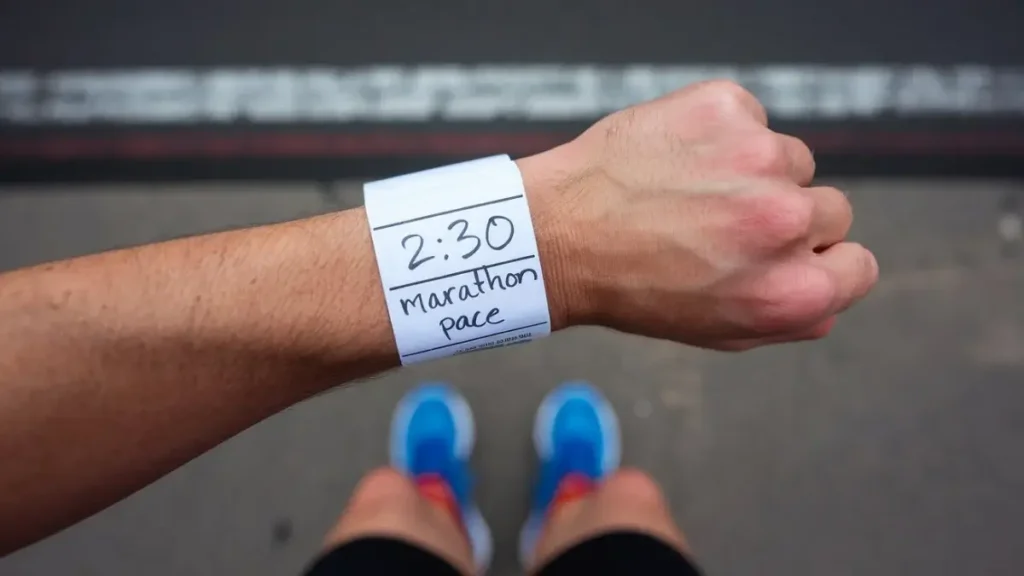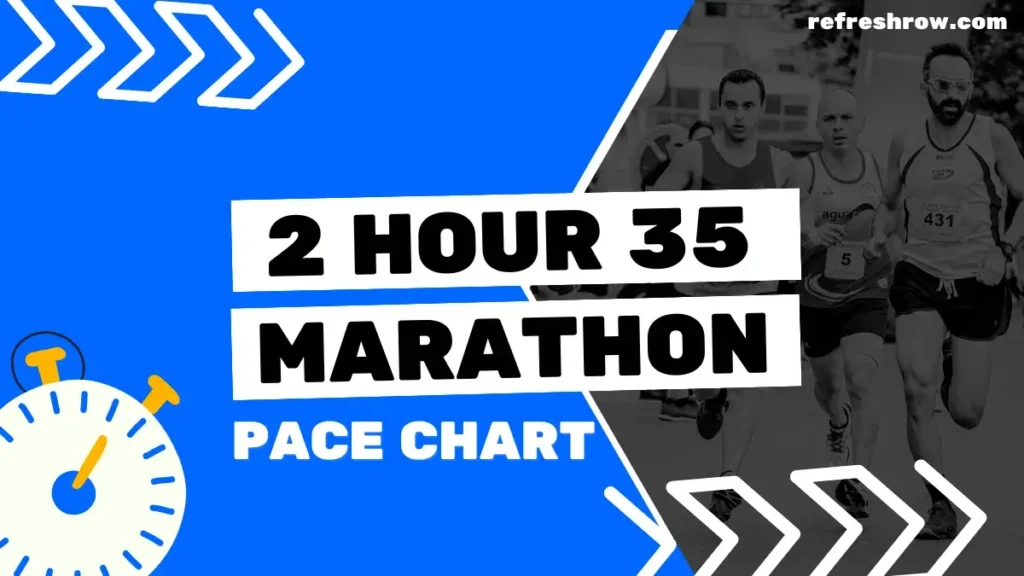To run a 4:45 hour marathon you need to run at a pace of 10:52 per mile or 6:45 per kilometer.
Following the splits below (and shaving off a second), you’ll run a sub 4:45 marathon.
I’d recommend aiming to run 1-2 minutes ahead of the split target time from 10 miles, as you’ll likely come up against crowding on race day.
4:45 Marathon Pace in Miles
| Mile | Split |
|---|---|
| 1 | 10:52 |
| 2 | 21:44 |
| 3 | 32:37 |
| 4 | 43:29 |
| 5 | 54:21 |
| 6 | 1:05:13 |
| 7 | 1:16:05 |
| 8 | 1:26:58 |
| 9 | 1:37:50 |
| 10 | 1:48:42 |
| 11 | 1:59:34 |
| 12 | 2:10:26 |
| 13 | 2:21:19 |
| 14 | 2:32:11 |
| 15 | 2:43:03 |
| 16 | 2:53:55 |
| 17 | 3:04:47 |
| 18 | 3:15:40 |
| 19 | 3:26:32 |
| 20 | 3:37:24 |
| 21 | 3:48:16 |
| 22 | 3:59:09 |
| 23 | 4:10:01 |
| 24 | 4:20:53 |
| 25 | 4:31:45 |
| 26 | 4:42:37 |
| 26.2 | 4:45:00 |
Download
4:45 Marathon Pace in KM
| KM | Split |
|---|---|
| 1 | 6:45 |
| 2 | 13:31 |
| 3 | 20:16 |
| 4 | 27:01 |
| 5 | 33:46 |
| 6 | 40:32 |
| 7 | 47:17 |
| 8 | 54:02 |
| 9 | 1:00:47 |
| 10 | 1:07:33 |
| 11 | 1:14:18 |
| 12 | 1:21:03 |
| 13 | 1:27:48 |
| 14 | 1:34:34 |
| 15 | 1:41:19 |
| 16 | 1:48:04 |
| 17 | 1:54:49 |
| 18 | 2:01:35 |
| 19 | 2:08:20 |
| 20 | 2:15:05 |
| 21 | 2:21:50 |
| 22 | 2:28:36 |
| 23 | 2:35:21 |
| 24 | 2:42:06 |
| 25 | 2:48:52 |
| 26 | 2:55:37 |
| 27 | 3:02:22 |
| 28 | 3:09:07 |
| 29 | 3:15:53 |
| 30 | 3:22:38 |
| 31 | 3:29:23 |
| 32 | 3:36:08 |
| 33 | 3:42:54 |
| 34 | 3:49:39 |
| 35 | 3:56:24 |
| 36 | 4:03:09 |
| 37 | 4:09:55 |
| 38 | 4:16:40 |
| 39 | 4:23:25 |
| 40 | 4:30:10 |
| 41 | 4:36:56 |
| 42 | 4:43:41 |
| 42.2 | 4:45:00 |
Download
Other Marathon Pace Charts
Targeting a different time?
Check out the Full Marathon Pace Chart in Miles or KM
Or select a specific finishing time below:
| 3:00 | 4:00 | 5:00 | |
| 3:05 | 4:05 | 5:15 | |
| 3:10 | 4:10 | 5:30 | |
| 3:15 | 4:15 | 5:45 | |
| 3:20 | 4:20 | 6:00 | |
| 3:25 | 4:25 | 6:15 | |
| 2:30 | 3:30 | 4:30 | 6:30 |
| 2:35 | 3:35 | 4:35 | 6:45 |
| 2:40 | 3:40 | 4:40 | 7:00 |
| 2:45 | 3:45 | 4:45 | |
| 2:50 | 3:50 | 4:50 | |
| 2:55 | 3:55 | 4:55 |
Training for a 4:45 Marathon
Is 4:45 a Good Marathon Time?
Well, what do the stats say?
Run Repeat conducted a study that contains 19,614,975 marathon results from more than 32,335 races across the globe, here is how a 4:45 marathon compares against age and gender for the races recorded:
| Overall | You’re faster than 35.0% of all runners. |
| Male | You’re faster than 25.8% of males. |
| Female | You’re faster than 47.4% of females. |
| <20 | You’re faster than 34.7% of under 20s. |
| 20-29 | You’re faster than 27.6% of 20-29 year olds. |
| 30-39 | You’re faster than 27.6% of 30-39 year olds. |
| 40-49 | You’re faster than 31.8% of 40-49 year olds. |
| 50-59 | You’re faster than 44.2% of 50-59 year olds. |
| >60 | You’re faster than 66.1% of over 60s. |
Training Runs and Paces for a 4:45 Marathon
To break a 4:45 marathon you’ll need to do some serious distance in your training, I recommend at least 15 miles (24km) per week.
You’re also going to need to make sure you’ve crossed off these milestones for other race distances:
- A 5k in 29:25
- A 10k in 1:01:50
- A half marathon in 2:10:00
Training Paces
| Pace | Mins per Mile | Mins per KM |
|---|---|---|
| Easy | 12:15 | 7:36 |
| Steady | 10:52 | 6:45 |
| 10k | 9:58 | 6:11 |
| 5k | 9:33 | 5:56 |
| 1 Mile | 8:52 | 5:33 |
Weekly Mileage Targets
| Target Mileage: | Gradually increase your weekly mileage from 18 miles (29 km) to a peak of 26 miles (42 km). |
| Incremental Increase: | Increase mileage by approximately 10% each week, with every fourth week as a recovery week where mileage is reduced by 20-30%. Make sure to taper for the last 1-2 weeks. |
Long Run Structure
| Total Distance: | Build up to long runs of 16-18 miles (26-29 km). |
| Segment Example: | First 5 miles (8 km): Easy pace, heart rate 140-150 bpm (approximately 13:15/mile or 8:14/km). Next 1 mile (1.6 km): Fast pace at 9:20/mile (5:48/km). Next 5 miles (8 km): Medium effort, heart rate around 160 bpm (approximately 10:20/mile or 6:25/km). Repeat: Repeat the segment twice (5 miles easy, 1 mile fast, 5 miles medium), you can taper the final 2 miles if required. |
Why This Works: Incorporating varied paces within long runs enhances lactate tolerance, which helps on race day when you’ve got to maintain pace despite feeling fatigued. By practicing surges during a run, you can build up your physical and mental resilience (lots of elite marathon runners use these strategies during their training)
Alternating Long Runs: Alternate between structured long runs (easy/fast segments) and easier long runs. For easier long runs, maintain a steady, comfortable pace throughout, focusing on mileage rather than speed to aid recovery.
Speedwork Sessions
| Short Intervals: | – 800m repeats at 4:45 per interval (5:55/km). – Aim for 5-7 repetitions with equal time for recovery. |
| Mile Repeats: | – 1 mile repeats at 9:20 per mile (5:48/km). – Aim for 4-6 repetitions with a 1-2 minute recovery jog. |
| Longer Intervals: | – 2 mile repeats at 9:30 per mile (5:54/km). – Aim for 3-4 repetitions with a 2-3 minute recovery jog. |
Recovery and Rest Days
| Rest Days: | You don’t need to incorporate rest days if you are using recovery runs, but I recommend taking 1 (or a max of 2) per week to allow your body to recover and prevent overtraining. |
| Easy Run Days: | Include 1-2 easy run days per week at a relaxed pace of 13:30/mile (8:23/km), covering 3-5 miles (5-8 km) per day. Try to keep your heart rate below 140 bpm on easy days to ensure proper recovery and aerobic development. |
My Tips to Run a Sub 4:45 Marathon
Build Up Gradually and Be Kind to Yourself
Gradual progression in your training is key.
I learned this the hard way by adding too many miles too quickly, leading to burnout.
Stick to the 10% rule – don’t increase your weekly mileage by more than 10% at a time.
Be patient with yourself, and if you have an off day or need an extra rest day, take it!
Your goal is to make it to race day healthy and strong, and sometimes that means listening to your body over sticking rigidly to the plan.
Focus on Time on Feet Rather Than Pace in Long Runs
Early on in your training, don’t stress too much about hitting specific paces on your long runs.
Instead, focus on spending time on your feet.
I find that building endurance for a marathon is about teaching your body to stay moving for hours, not necessarily running fast.
Try to hit a few long runs where you’re out for the same amount of time you expect to spend on race day, even if you mix in walking or slow down significantly.
This will build the physical and mental endurance needed to finish strong.
Make Time for Mental Training
One aspect of marathon training I didn’t fully appreciate until I started racing was the mental side.
For your 4:45 marathon, there’s a lot of time to think, and that can either help or hurt you.
I started incorporating mental training into my long runs – practicing staying positive, breaking the run into smaller, manageable sections, and visualizing myself crossing the finish line.
These mental tools kept me focused and calm when things got tough around mile 20.
Practice telling yourself: “I’ve got this”, and break the race into 5-mile sections to mentally tackle it in chunks.
Use Recovery Days Wisely
Recovery days aren’t just about doing nothing – they’re about active recovery.
Your body will appreciate days when you go for an easy walk, do some light stretching, or even a short recovery run at a very relaxed pace.
This helped me stay loose and avoid stiffness while still giving my body a chance to heal.
Prioritize recovery, especially after your long runs, and don’t be afraid to give yourself extra time to rest when needed.


Row Brown is the founder of Refresh Row. He is a keen marathon runner, his favorite being the London Marathon. He’s now set himself the mission of Running the Entire Length of Spain, which is scheduled for late 2024.


